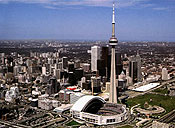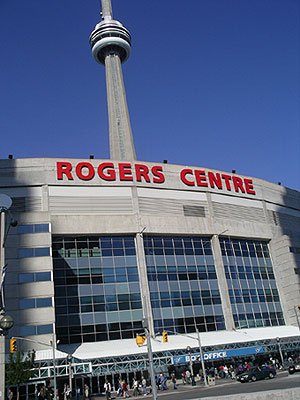
|
The Rogers Centre in Toronto was built complete with functions and features that ushered in a new era of ballpark building. Ironically, it was also the last multipurpose stadium built to satisfy the needs of two sport franchises.
When it opened in 1989 under the name SkyDome, Toronto’s landmark stadium was lauded as one of the architectural wonders of the modern world, much like the AstroDome was upon its construction in 1965. But today the Blue Jays’ home manages to serve as a reminder of the gap that exists between old stadium construction and new ballpark building. The Rogers Centre was the first ballpark of its kind on many levels, but its circular design and symmetrical outfield dimensions are reminiscent of the cookie-cutter donuts of yesteryear. Opening just a couple of years before the retro ballpark craze began in Baltimore, the SkyDome was the last fully enclosed stadium built for use in the Major Leagues, but it was also the first to successfully incorporate a fully retractable roof. The roof itself is what made the SkyDome an engineering marvel. The world's first fully retractable roof cost $100 million to construct and is made up of four sections that open in a smooth, circular motion. Rising 282 feet (the equivalent of a 31-story building) above the playing field at its highest point, the roof can open and close in just 20 minutes. One of the nicest aspects of the retractable roof at the Rogers Centre is that the Blue Jays actually keep it open for the majority of games, unlike the four teams who have built a retractable roofed ballpark since Toronto pioneered the concept. The decision over whether the Rogers Centre roof will be open or closed for regular-season games rests solely with Toronto management and the roof was closed just twice during a game in the Blue Jays’ inaugural year in the dome, and very infrequently (four or five times a year) since then. With the roof open, 100% of the field and 91% of the seating area is exposed. Although the roof was the first of its kind, the Rogers Centre is more famous for its center field diversions and stunning choice of location. Toronto became the first - and remains the only - ballpark to have a hotel built into it. With 348 rooms, the Renaissance Hotel looms large just beyond the center field fence, and 70 of its rooms overlook the playing field. Four stories of the hotel are visible from anywhere in the ballpark, and a handful of the Renaissance’s suites come within a few feet of the upper level outfield seats. Attached to the center of the hotel is the largest video display board in North America. Measuring 115 feet wide by 33 feet high and operating with 420,000 light bulbs, the Toronto Jumbotron displays with crystal clarity both team’s line-ups, player information and game stats. Directly below the scoreboard is the Sightlines Club, an open, two-tiered 300-foot bar with all 280 of its seats facing the playing field. The size of Sightlines pales in comparison to the enclosed 520-seat Windows restaurant built below it, and the Rogers Centre is also home to a satellite location of Toronto’s Hard Rock Café, which was built between levels of the right field seats. Another restaurant overlooks the field from the Renaissance Hotel and a health club is also part of the building.
First and foremost is the 1,815-foot CN Tower, which is so enormous that you can’t get a picture of it and the ballpark to fit within a frame. Twice as tall as the Eiffel Tower, the CN Tower is the world's tallest building and dominates the Toronto landscape. The tower is the Rogers Centre’s neighbor and the two share an entrance on the first base side of the stadium. As if a world-renowned skyscraper wasn’t enough to grab your attention, recent development on the third base side of the stadium has spawned the CityPlace Condos, which also tower above the ballpark’s upper reaches. The condos are part of a fully planned, 20-building downtown urban community and four of the buildings have become a part of the backdrop at the Rogers Centre. The presence of the CN Tower and CityPlace Condos has actually created a better atmosphere for Blue Jays games. Although the Rogers Centre is big on the scale of Shea Stadium, these surrounding buildings make Toronto’s ballpark feel intimate, so the choice of its exact downtown location is ideal. The ballpark is a short walk from the Union Station subway stop, which drops you off at Front Street. Despite its size, the Rogers Centre isn’t visible from where the subway drops people off, so first time visitors should just follow the crowd and head towards the CN Tower. Along the way, numerous hot dog and sausage carts line Front Street, as do plenty of bars and restaurants, adding to a nice game day feel. Ticket scalpers are plentiful, especially on the 12.7 acres of land that the Rogers Centre occupies. The scalpers are noisy and proudly sell tickets at less than face value. Be aware that if you buy a ticket for the upper deck (500 level) there is no way to get to the lower levels, as the elevators are stationed with security personal that won’t let you downstairs unless you have a ticket for that level.
Sitting in the upper deck in Toronto can also get a little chilly, as the breeze from nearby Lake Ontario wafts in. Many sections of the upper deck are closed, as the Blue Jays’ attendance has dwindled since the record setting pace that existed in the years after the SkyDome first opened. With a seating capacity of 50,516 for baseball, there was a time when the Rogers Centre's seats, all of which are painted in hues of blue that represent the Blue Jays’ team colors, were packed every night. Between the novelty of a new stadium and the Blue Jays winning the World Series in 1992 and 1993, fans had many reasons to flock to the SkyDome in the early 1990s. As a result, Toronto became the first franchise in the history of professional sports to draw more than 4 million fans in a season, a feat they accomplished in three consecutive seasons (1991-93). Although the team has remained fairly competitive since their glory years, attendance in Toronto has not topped 2 million since 1999. Rogers Communications, which has owned the Blue Jays since 2000, bought the SkyDome and renamed it Rogers Centre on February 2, 2005. After the purchase was complete, the only remaining AstroTurf surface in MLB was replaced with FieldTurf and out of town video scoreboards were placed on the outfield walls. Although the Blue Jays do not retire numbers, they honor players and personnel with a banner in the Level of Excellence. A total of eight banners have been placed on the façade of the 500 level directly below suites from the Renaissance Hotel. Listed in order from left to right are Tony Fernandez, George Bell, Joe Carter, Cito Gaston, Jackie Robinson, Dave Stieb, Tom Cheek (announcer), and Pat Gillick. Although no numbers have been retired by the Blue Jays, four numbers have been retired by Rogers Centre’s other tenant, the Toronto Argonauts of the Canadian Football League. Those numbers are placed next to two banners that list the All-Time Argos. From the street level outside, the Rogers Centre has a rectangular shape on one end, which makes it easy to envision football being played inside, although you can tell on the inside that the stadium was built primarily for baseball. The conversion process to change the field from baseball to football use takes approximately 10-12 hours. The favorite sport of the city (and country) is played a couple of blocks away, where the Air Canada Centre is home to the Toronto Maple Leafs of the NHL. I learned from my visit that a preseason hockey game garners more media attention in Toronto than a regular season Blue Jays game, but the crowds at the baseball game are boisterous and remain so during the many between innings promotions shown on the center field Jumbotron. Besides singing the American national anthem after the Canadian nation anthem, the only real difference between Major League baseball viewed in the USA and Canada is the drinking age, which is 19-years old north of the border. Toronto is definitely an interesting place to watch a ballgame, regardless of age. Yes, it is a big, circular stadium, but the structure is dwarfed to the point of being quaint by its surroundings inside and out. You can’t help but be in awe of the wide screen center field scoreboard, until you tilt your head back to see how high the CN Tower reaches. All of this makes you forget that you are in the tallest ballpark in the majors. The SkyDome was the first ballpark to feature the modern entertainment amenities that fans have come to expect, an innovation which paved the way for similar year-round additions at other ballparks, all of which are designed to keep them in use regardless of whether the home team is actually at home. Although its basic design is bland and its multipurpose use makes the label stadium more appropriate than ballpark, the Rogers Centre remains a unique baseball experience. It can proudly take credit as the forefather to many of the features found in today’s newest ballparks. Originality had to start somewhere, and for America’s national pastime that place was Toronto.

Rogers Centre Footnotes - Facts & Figures
| ||||||||||||||||||||||||||||||||||||||||



 The tremendous amount of commercial development inside the stadium is actually obscured by the buildings that cast their shadows onto the Rogers Centre’s playing field.
The tremendous amount of commercial development inside the stadium is actually obscured by the buildings that cast their shadows onto the Rogers Centre’s playing field.
 One of the truly odd things about the upper deck in Toronto is the presence of blue railings used to separate each row. Such bars were once commonplace in the box seats of older ballparks, and still exist in those sections at
One of the truly odd things about the upper deck in Toronto is the presence of blue railings used to separate each row. Such bars were once commonplace in the box seats of older ballparks, and still exist in those sections at 